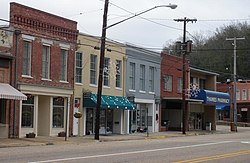Wetumpka
History
The name Wetumpka is a historic Creek place word meaning “rumbling waters”, supposedly a description of the sound of the nearby Coosa River as the water falls over the rapids of the Devil’s Staircase. It could be heard for miles before the construction of dams.[citation needed] The Creek named Wetumka, Oklahoma after their historic village after being forced west to Indian Territory (present-day Oklahoma), by United States soldiers by the Indian Removal Act of 1830.[citation needed]
Overview
Wetumpka is a city in Elmore County, Alabama, United States. At the 2010 census the population was 6,528. The city is the county seat of Elmore County, one of the fastest growing counties in the state. The city is considered part of the Montgomery Metropolitan Area.
Wetumpka promotes itself as “The City of Natural Beauty”. Among the notable landmarks are the Wetumpka crater and the Jasmine Hill Gardens, with a full-sized replica of the Temple of Hera of Olympia, Greece, the Coosa River that runs through historic downtown Wetumpka, and Fort Toulouse which is also on the Coosa River.
Geography
The area around Wetumpka was the heart of the Upper Creek lands, whose largest towns were located on the banks of the Tallapoosa River and Coosa River at Wetumpka and Talisi (now Tallassee). After moving the 1702 settlement of Mobile to Mobile Bay in 1711, Jean-Baptiste Le Moyne, Sieur de Bienville sent an expedition up the Alabama River to establish a fort in the interior of New France, both to stop the encroachment of the British and to foster trade and goodwill with the Creek.
He had Fort Toulouse constructed in 1714, 4 miles (6.4 km) above the Coosa-Tallapoosa rivers’ confluence at the Creek village of Taskigi. Bienville selected this area as a strategic locale for a fortification.
The French traded at Wetumpka and garrisoned Fort Toulouse until 1763, when they ceded the territory to the British following defeat in the Seven Years’ War (known as the French and Indian War in North America).
Demographics
The area around Wetumpka was the heart of the Upper Creek lands, whose largest towns were located on the banks of the Tallapoosa River and Coosa River at Wetumpka and Talisi (now Tallassee). After moving the 1702 settlement of Mobile to Mobile Bay in 1711, Jean-Baptiste Le Moyne, Sieur de Bienville sent an expedition up the Alabama River to establish a fort in the interior of New France, both to stop the encroachment of the British and to foster trade and goodwill with the Creek.
He had Fort Toulouse constructed in 1714, 4 miles (6.4 km) above the Coosa-Tallapoosa rivers’ confluence at the Creek village of Taskigi. Bienville selected this area as a strategic locale for a fortification.
The French traded at Wetumpka and garrisoned Fort Toulouse until 1763, when they ceded the territory to the British following defeat in the Seven Years’ War (known as the French and Indian War in North America).
| Wetumpka, Alabama | |
|---|---|
| City | |
 |
|
| Nickname(s): City of natural beauty | |
 Location in Elmore County and the state of Alabama
Location in Elmore County and the state of Alabama |
|
| Coordinates: 32�32?27?N 86�12?28?W / 32.54083�N 86.20778�W / 32.54083; -86.20778 | |
| Country | United States |
| State | Alabama |
| County | Elmore |
| Government | |
| o Type | Mayor/ Councial |
| o Mayor | Jerry Willis |
| Area | |
| o Total | 8.9 sq mi (23 km2) |
| o Land | 8.5 sq mi (22 km2) |
| o Water | 0.4 sq mi (1 km2) |
| Elevation | 200 ft (61 m) |
| Population (2010) | |
| o Total | 6,528 |
| o Density | 645.4/sq mi (249.2/km2) |
| Time zone | Central (CST) (UTC-6) |
| o Summer (DST) | CDT (UTC-5) |
| ZIP codes | 36092-36093 |
| Area code(s) | 334 |
| FIPS code | 01-81720 |
| GNIS feature ID | 0155305 |
| Website | http://www.cityofwetumpka.com/ |


